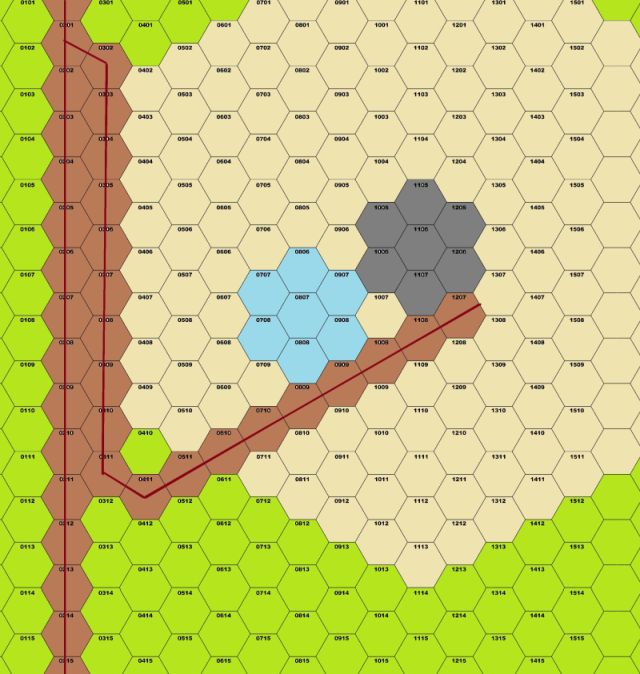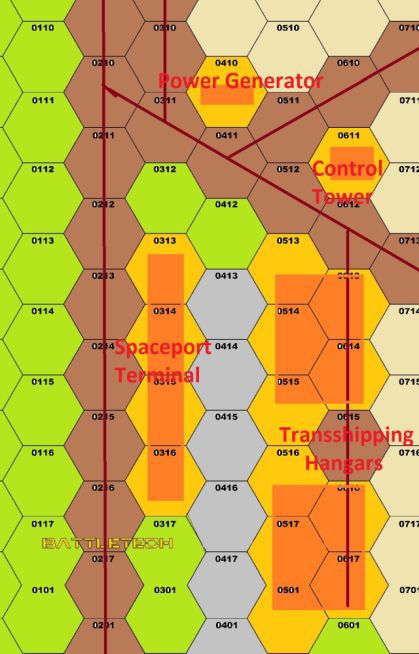Here's some stuff - technically not quite right here, but it's aerospace
infrastructure after all...
The initial setup would look like this:

Basically, just branching off that existing rail line running vertical with a siding and a track branching off to our landing field with its water depot next door. Our train would sit next to it, and for the Poseidon to lift off or land would move over to the siding temporarily. And yeah, that blue there is our water depot crater.
Our train would initially only consist of two powered railcars and 18 fuel cars.
Class 275 Power RailcarTech Level C box rail car, powered, 190 tons
53.0 tons - chassis, tractor
27.0 tons - fission engine (6/9)
0.5 tons - armour (20 points BAR2 - 5f/5l/5r/5a)
1.0 tons - communications
21.0 tons - quarters, second class, crew (3)
8.0 tons - exoskeleton bay (4 exoskeletons nominal)
79.5 tons - bulk storage:
- 11.5t spare parts train (15 months)
- 45.0t spare parts dropshuttle (15 months)
- 23.0t consumables (15 months)
Cost: 1,265,661 C-Bills each
Type-14 Fuel Tank rail carTech Level C box rail car, unpowered, 21 tons
5 tons - chassis, tractor, trailer
16 tons - fuel tank
The two locomotives would run us 1,265,661 C-Bills each, while the eighteen fuel cars are a steal at only 14,648 C-Bills each. With 18 fuel cars we can 250t of fuel to a dropshuttle.
Our first flight - using a Pontos - would bring in this full train plus construction materials. As a little bribe to the host colony - for using their rail line - we can even bring in a pair of standardized powered passenger rail cars for them, typically bought used (price, new: 485,595 C-Bills) and simply transported there for free:
Pollux 200 Commuter TrainTech Level C, box rail car, powered, 47 tons
9.5 tons - chassis
12.0 tons - fuel cell engine (9/14)
5.0 tons - fuel (2777 km range)
0.5 tons - armour (20 points BAR2 - 5f/5l/5r/5a)
20.0 tons - foot infantry bay (112 people)
These railcars later come in handy as well - because, after all, we're trying to make a business here, and with that we have to expand. So, with only a second Pontos flight, we bring in everything we need to install a small spaceport.

So, basically just a second landing field, extending the tracks there, and a couple buildings. Let's look into those:

The setup of that is actually pretty simple. We've got a control tower, a power generator, a small terminal and a pair of hangars that we can use for both storage and to shift loads over to trucks for those customers who disdain proper transport.
Infrastructure is relatively simple. That control tower - CF16 light building, 1-hex/4-level - basically just hosts 6 tons of communications gear, while the terminal - CF40 medium building, 4-hex/2-level - only hosts a duty-free shop and a small hotel for 20 guests. In addition, between these two buildings, there's accomodation for 29 employees now working on site - 6 for the comms, 21 for the now actually manned landing field and 2 for the shop. We even have sufficient supplies for these guys and the hotel guests for two months on-site. The power generator of course runs fission, and at 90 tons even has sufficient spare capacity to further expand the spaceport later on without needing a new power supply.
The two transshipment hangars - CF45 heavy hangars, 5-hex/2-level - are somewhat special. Effectively, each of them consists of a drive-through pair of (light vehicle) bays for rail cars up to 50t weight, as well as - towards that road - a single (medium vehicle) bay where a truck can be loaded. Each hangar can store some 375 tons on top of that - not quite half the load of a Pontos between the two of them, but sufficient for most dropships of the time.
And when the spaceport's not busy, those hangars make a good site for the local farmers to load their goods for transport to the larger towns at the ends of that rail line.
We'll need something to move some freight around of course. You guess it, we're bringing in a few flatcars on the same flight. Six of them nicely fit our weight budget. Don't need a locomotive, we can just use one of the two already there since it's only standing around.
Container CarTech Level C, flat car, unpowered, 40 tons (9t empty)
9.0 tons - chassis, tractor, trailer
31.0 tons - bulk cargo storage, external
As they're a bit bigger than the fuel cars these run for 21,533 C-Bills each.
From here on? A few hundred tons, and we can extend both of those rail branches outwards for a pair of extra landing fields. Then we're really in business.